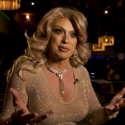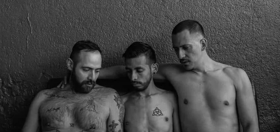You’ve probably seen them out and about, or maybe on TV: a group of strange nuns, manly and often bearded, covered in gems or feathers or polka dots or fur or any manner of strange decorations. They’re usually collecting money for a cause, and they’re the Sisters of Perpetual Indulgence — a group that’s part protest, part performance, part charity and 100% wonderful.
The sisters have been going strong for nearly 40 years, and like any group they’ve had their up and downs over the years.
Here are a few of the most amazing moments in their history — and what they’re up to today.
1. Tricia Nixon’s Wedding
How about we take this to the next level?
Our newsletter is like a refreshing cocktail (or mocktail) of LGBTQ+ entertainment and pop culture, served up with a side of eye-candy.
The sisters trace their history back to the unruly Castro district of the 1970s but their spirit dates back to San Francisco’s Summer of Love, the birth of the counter-culture movement with its emphasis on free love, non-conformity and peace. Back in the 70s, the neighborhood we know as queer was shedding its Irish Catholic past, and electing leaders like Harvey Milk.
In this climate, some truly daring art began to flourish. That included the Cockettes and the Angels of Light, to odd experimental theater groups. One of their early performances was a mock-wedding between Richard Nixon’s daughter, Tricia, and her husband Edward Cox. In the show, both parts were played by men, and the show culminates in an orgy touched off by Eartha Kiss spiking the punch with LSD.
“Hippie acid freak drag queens” is how John Waters referred to them, and it was in this bizarre, no-holds-barred environment that the sisters were formed.
2. Easter Weekend and the October Chase

The sisters first appeared as three nuns on Easter Weekend in 1979. They’d obtained the habits from a convent in Iowa by pretending that they were going to stage a production of The Sound of Music, but instead, they simply dressed up and wandered the city. The men would pop up occasionally at the nude beach, street fairs, and sporting events.
This was at a time that the Castro had been targeted by various religious groups for harassment, and it was not uncommon to see gangs of street preachers bothering residents. One night in October of 1980, the group of drag-nuns, led by one calling themselves Sister Missionary Position, chased and heckled the harassers until they departed. By now, there were around a dozen of these people, and they began holding charitable events for the Metropolitan Community Church. They also developed a mission statement:
We believe all people have a right to express their unique joy and beauty and we use humor and irreverent wit to expose the forces of bigotry, complacency and guilt that chain the human spirit.
3. Heroes of the Epidemic
They couldn’t have known it when they formed, but the Sisters were in a position to make a tremendous impact during the worst of the HIV epidemic. One of them, a registered nurse named Bobbi Campbell, went out in drag as Sister Florence Nightmare and educated the community about safe sex until he passed away in 1984. At the 1986 Castro Street Fair, the sisters organized a pie-throwing booth with the slogan “Cream yer Sister, not your lover!”
4. Official Heretics

The sisters were also highly political. Sister Boom Boom (also known as Jack Fertig) ran for Board of Supervisor, listing his drag name and his occupation as “Nun of the Above.” The city scrambled to enact a law that people could not run for office under an assumed name.
The sisters also staged a public exorcism against Phyllis Schlafly during the 1984 Democratic National Convention. Later, the sisters protested Lyndon LaRouche, a wealthy crackpot who’d been aspiring to the presidency for the last few decades. LaRouche advocated for quarantining people with HIV. They also protested Cardinal Ratzinger, a church official who accused gays of causing their own attacks. This was summarized in a newspaper headline: “Pope to Gays: Drop Dead.” The group was soon listed on the Vatican’s official list of heretics.
5. The Rise and Fall of Halloween

How did Halloween become one of the most important holidays on the gay calendar? Because it was the one time drag queens could don their outfits in public without fear of arrest, as far back as the 1940s. The Sisters were, not surprisingly, an instrumental force in making the Castro a don’t-miss destination for celebrating. Eventually, the party outgrew the Castro, and had to be shut down. As recently as 1989, the Sisters used Halloween night to collect donations for victims of the massive Loma Prieta earthquake, which had hit the region just two weeks before.
6. Clutching at Pearls

The Sisters have made a few enemies over the years, mostly from self-described Christians who are more concerned with how people dress than whether they do charitable works. When the Sisters wanted to stage a “Hunky Jesus” contest on Easter, local church officials tried to have the event moved. And when they were to be grand marshals of Reno’s Pride parade, Nevada’s governor Kenny Guinn refused to support the event, saying that the sisters “cross the line of decency.” Right, because raising tens of thousands of dollars for people in need is highly indecent.
7. Aggressively Gay

Back in the 90s, Bill Clinton nominated openly gay philanthropist James Hormel as ambassador to Luxembourg, but the appointment was held up by Congressman Chuck Hagel because of, that’s right, the Sisters. At the time, a tape had emerged in which Hormel can be seen laughing at an appearance by the Sisters, and tried to block the appointment by calling Hormel too aggressive with his gayness.
8. Community Leaders

As the Sisters became a permanent fixture of the community, they began working hand-in-hand with government officials and community leaders. For example, these days Sisters Mary Juanita of a Higher Power and Mona Little More serve as roadies on the AIDS Lifecycle. The group is a force behind Pink Saturday, the Castro festival that marks both Pride and the Frameline film festival. And internationally, Sisters Roma and Flatulina Grande serve as “Style Police” at Vienna Life Ball, the largest annual AIDS fundraiser in Europe, levying good-natured fines against donors whose outfits were deemed insufficiently fancy.
9. Saving the Eagle

When it was reported that The Eagle, a cornerstone of the city’s queer community, would be closing down, the sisters leapt into action. The Sisters had a close relationship with the bar, hosting many of their fundraisers there, and had previously named it an official “Sanctuary.” After the news hit, Sister Tuna Noodle Cocktail arranged for “Eagle in Exile” nights at the nearby El Rio, and kept the spirit of the old Eagle alive. Fortunately, after a concerted effort to hold on to the city’s traditions, the doors of the bar remain open to this day.
10. Rural Sisters
Today, Sisters can be found in major cities around the world. But you might catch a glimpse of them in small towns, too. There’s a strong contingent around the Russian River, a getaway spot a few hours north of San Francisco. They host bingo nights and fundraisers, and over the last 15 years have raised $1.5 million. Among their beneficiaries: the local school and senior center.
It’s a perfect reminder of the Sisters’ mission: helping all people, young and old, and making the world a better place.



















